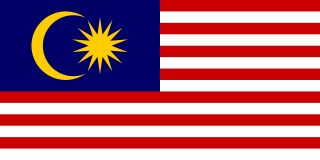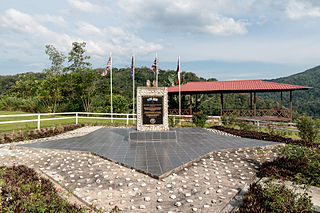 W
WNorth Borneo was a British protectorate located in the northern part of the island of Borneo. The territory of North Borneo was originally established by concessions of the Sultanates of Brunei and Sulu in 1877 and 1878 to a German-born representative of Austria-Hungary, a businessman and diplomat, von Overbeck.
 W
WThe 20-point agreement, or the 20-point memorandum, is a list of 20 points drawn up by North Borneo, proposing terms for its incorporation into the new federation as the State of Sabah, during negotiations prior to the formation of Malaysia. In the Malaysia Bill of the Malaysia Agreement some of the twenty points were incorporated, to varying degrees, into what became the Constitution of Malaysia; others were merely accepted orally, thus not gaining legal status. The 20-point agreement often serves as a focal point amongst those who argue that Sabah's rights within the Federation have been eroded over time.
 W
WThe Battle of Borneo was a successful campaign by Japanese Imperial forces for control of Borneo island and concentrated mainly on the subjugation of the Raj of Sarawak, Brunei, North Borneo, and the western part of Kalimantan that was part of the Dutch East Indies. The Japanese main unit for this mission was the 35th Infantry Brigade led by Major-General Kiyotake Kawaguchi.
 W
WThe Crown Colony of Labuan was a British Crown colony on the northwestern shore of the island of Borneo established in 1848 after the acquisition of the island of Labuan from the Sultanate of Brunei in 1846. Apart from the main island, Labuan consists of six smaller islands; Burung, Daat, Kuraman, Papan, Rusukan Kecil, and Rusukan Besar.
 W
WThe Crown Colony of North Borneo was a British Crown colony on the island of Borneo established in 1946 shortly after the dissolution of the British Military Administration. The Crown Colony of Labuan joined the new Crown Colony during its formation. It was succeeded as the state of Sabah through the formation of the Federation of Malaysia on 16 September 1963.
 W
WThe Governor of North Borneo was the appointed head of the government of North Borneo.
 W
WThe history of Sabah can be traced back to about 23–30,000 years ago when evidence suggests the earliest human settlement in the region existed. The history is interwoven with the history of Brunei and the history of Malaysia, which Sabah was previously part of and is currently part of respectively. The earliest recorded history of Sabah being part of any organised civilisation began in the early 15th century during the thriving era of the Sultanate of Brunei. Prior to this, early inhabitants of the land lived in predominantly tribal societies, although such tribal societies had continued to exist until the 1900s. The eastern part of Sabah was ceded to the Sultan of Sulu by the Sultan of Brunei in 1658 for the former helping a victory over Brunei enemies, but many sources stated it had not been ceded at all. By the late 19th century, both territories previously owned by Sultan of Brunei and Sultan of Sulu was granted to British syndicate and later emerged as British North Borneo under the management of the North Borneo Chartered Company. Sabah became a protectorate of the United Kingdom in 1888 and subsequently became a Crown colony from 1946 until 1963, during which time it was known as Crown Colony of North Borneo. On 16 September 1963, Sabah merged with Malaya, Sarawak and Singapore to form Malaysia.
 W
WLabuan, officially the Federal Territory of Labuan, is a Federal Territory of Malaysia. It is made up of the eponymous Labuan Island and six smaller islands, and is located off the coast of the state of Sabah in East Malaysia. Labuan's capital is Victoria and is best known as an offshore financial centre offering international financial and business services via Labuan IBFC since 1990 as well as being an offshore support hub for deepwater oil and gas activities in the region. It is also a tourist destination for people travelling through Sabah, nearby Bruneians and scuba divers. The name Labuan derives from the Malay word labuhan which means harbour.
 W
WThe Last POW Camp Memorial is a memorial in the district of Ranau in the Malaysian state of Sabah, which commemorates the victims of the Sandakan Death Marches who died during their march to Ranau. Of 1,047 British and Australian prisoners of war, only 189 survived to reach this site which is located near Liwagu Valley. Of these 189 total, 153 prisoners died in the next six weeks, 32 were murdered, while only four managed to escape. The current memorial was built where the former camp was located.
 W
WThe Malaysia Act 1963 was an Act of Parliament in the United Kingdom. It came into operation on 31 July 1963.
 W
WThe Malaysia Bill is an annex of the Agreement relating to Malaysia between United Kingdom of Great Britain and Northern Ireland, Federation of Malaya, North Borneo, Sarawak and Singapore. It gave effect to the Agreement where that the British colonies of North Borneo, Sarawak and the State of Singapore should be federated with the existing States of the Federation of Malaya and the name of the federation should be Malaysia, and the Federal constitution wherewith to amend and adopt the Constitution of the Federation of Malaya so as to provide for the admission of those States. it adopted its present name, the name of the Constitution of the Federation of Malaya should be changed into Constitution of Malaysia.
 W
WThe Mat Salleh Rebellion was a series of major armed disturbances against the colonial British North Borneo Chartered Company administration in North Borneo, now the Malaysian state of Sabah. It was instigated by Datu Muhammad Salleh, a local chief from the Lingkabo district and Sugut River. He led the rebellion between 1894 until his death in Tambunan in 1900. The resistance then continued on for another 5 years until 1905.
 W
WThe North Borneo Chartered Company (NBCC), also known as the British North Borneo Company (BNBC) was a British chartered company formed on 1 November 1881 to administer and exploit the resources of North Borneo. The territory became a protectorate of the British Empire in 1888 but the company remained involved with the territory until 1946, when administration was fully assumed by the Crown colony government.
 W
WThe North Borneo Federation, also known as North Kalimantan or Negara Kesatuan Kalimantan Utara in Malay, was a proposed political entity which would have comprised the British Colonies of Sarawak, British North Borneo and the protectorate of Brunei.
 W
WNorth Borneo Self-government Day is a self-government day celebrated on 31 August every year by the state of Sabah in Malaysia. Since 2012, the holiday has been received widely by the Sabah state government and the citizens of Sabah, as the Hari Merdeka was not the right celebration day for the state.
 W
WThe Sandakan camp, also known as Sandakan POW Camp, was a prisoner-of-war camp established during World War II by the Japanese in Sandakan in the Malaysian state of Sabah. This site has gained notoriety as the Sandakan Death Marches started from here. Now, part of the former site houses the Sandakan Memorial Park.
 W
WSt. Michael's and All Angels Church or for short St. Michael is an Anglican church in the Malaysian city of Sandakan in the state of Sabah in northern Borneo. St. Michael is the oldest stone church in Sabah. The impetus for the construction of the church dates back to the clergyman William Henry Elton, who is also known as the founder of St. Michael's Secondary School, located next to the church.